Ideal Spaces
Ulrich Gehmann
What is an ideal space, what is the ideal about it? An ideal space can denote both a space imagined, and a space ‘ideal’ in the word’s common sense as a space perfected. Both meanings overlap, since a ‘perfect’ space has also to be imagined first. Referring to its Greek origins, “ideal” comes from idea, an (inner) image of something, and from eidos, image. Ιδέα denotes the appearance of something, its overall look or gestalt; the nature or character of something, its way (of being); a conception, a blueprint-image, an idea1.

These manifold meanings of an ‘idea’ are important for our entire work at Ideal Spaces Working Group. Without etymology, architecture couldn’t be understood, says architect Gottfried Semper. “The roots of words preserve their vitality intact, and through subsequent changes and extensions of related concepts always re-emerge in their original form. It is impossible for a new concept to coin an absolutely new term without falling short of its main objective which is to be understood; therefore, we can neither neglect nor reject the archaic art types at the origin of this symbolism and choose others instead.”3
On ideas and symbols
Interestingly, symbolism has been mentioned. What is a symbol? It is not what its modern and recent usage presumes it to be, namely a mere representation of something. Representation, in formal terms the “presentation of a content through another, and inside another content“(Cassirer), has advanced to the modern form of knowing per se, states Foucault, because the entire modern knowing is based on a paradigmatic distance between the things and their representations.4 This too is important for our work because such a mindset hinders true imagination. We have difficulties to imagine that the above image is just a part of an entire world of comparable style, and not just a “representation of some imagined reality” in the sense, and mental as well as psychological manner, of that paradigmatic distance. Ideas are about imagination, true imagination. The latter means the capability to really dive into something, it owns an emotional component, the capability to have a holistic view upon something, to realize its totality, and therefore, to endorse it with life. We can imagine the missing parts of the above world, how it would look outside the boundaries of the photo, what kind of world it could be.
Whereas the paradigmatic distance leads to a look upon the world which is merely technical and rational, the real things become mere “interpretations”, they are no longer the real things. The world as such turns into a mere individual interpretation, we do not know what the real things are and how they feel; we just construct our rational graphs of them, and around them.
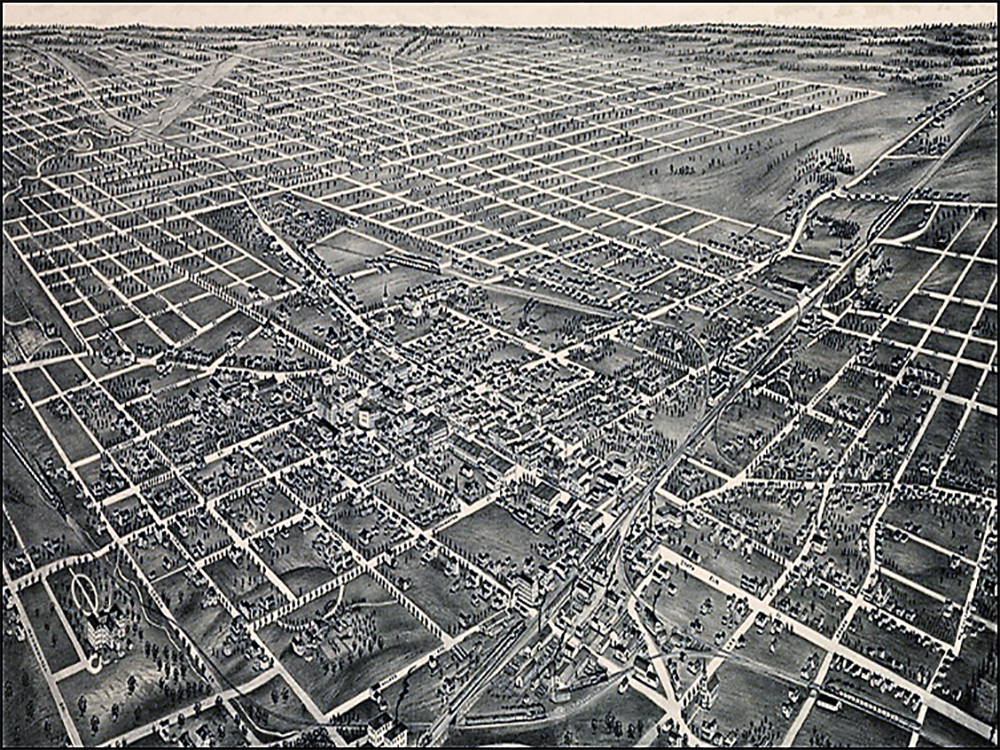
Seen from this background, a symbol is more than just a “representation” of something else that might completely differ (as a formula for instance, describing actual relationships).Originally, a symbol was used as a term for (re-)cognition: it was a coin broken into two halves. So, even after a long time of absence, the bearers of the pieces could recognize each other by putting them together. A symbol signifies.
But: despite it is significant in literal sense, a symbol is not identical with a sign in its modern meaning, in being a mere abbreviation for something else. A symbol is not just a sign, it does not just indicate something, but is a full representative standing for its counterpart (as in case of a coin’s half). Being such full representatives, symbols are comprehensively standing for what it is actually about, they are Sinnbilder in German, images conveying a certain meaning.6 If understood, a symbol is able to reveal. For instance, the above image reveals a certain mindset of how to treat world, and space, in general. According to Goethe, symbols are able to transform ideas into images, and visible phenomena into ideas; in such a way that “the idea stays forever effective in the image.”7 One has to look at the above image to comprehend such a saying’s full meaning.
On ideas, images, and symbolic worlds
It needs an imaginative comprehension, starting with perception, aesthetics in its original meaning as the capability of aisthesis, of perceiving a whole and not just parts. This kind of holistic perception stands for the perception of an entire context of meaning, it is not identical with a today’s “aesthetics of design”8 but about wholeness, and evidence, the unity of expression and meaning. The holistic quality of an imaginative comprehension is also reflected etymologically. At the historical base of an occidental thinking, there was no distinction between different modes of perception and conceiving which became rationalized and separated only later on. Eidos, the “image”, equally denoted gestalt (morphe), idea, form, blueprint; between these notions, there were no sharp differences.9
The symbolic reality of the image we see – e.g., the above gridded landscape expressing a certain mindset and world view – refers to a wider, more encompassing reality for which the image is only a representative. The imaginative process now consists in “the transfer of a segment of a world (shown in the image) into an encompassing image of that world.”10 That we get an idea of what such a world is all about in its totality, by which mindset it is constructed. That we can imagine (a word that encloses imago, image) what such a world is, in its essence, by experiencing its reference space that is shown here, as pars pro toto.
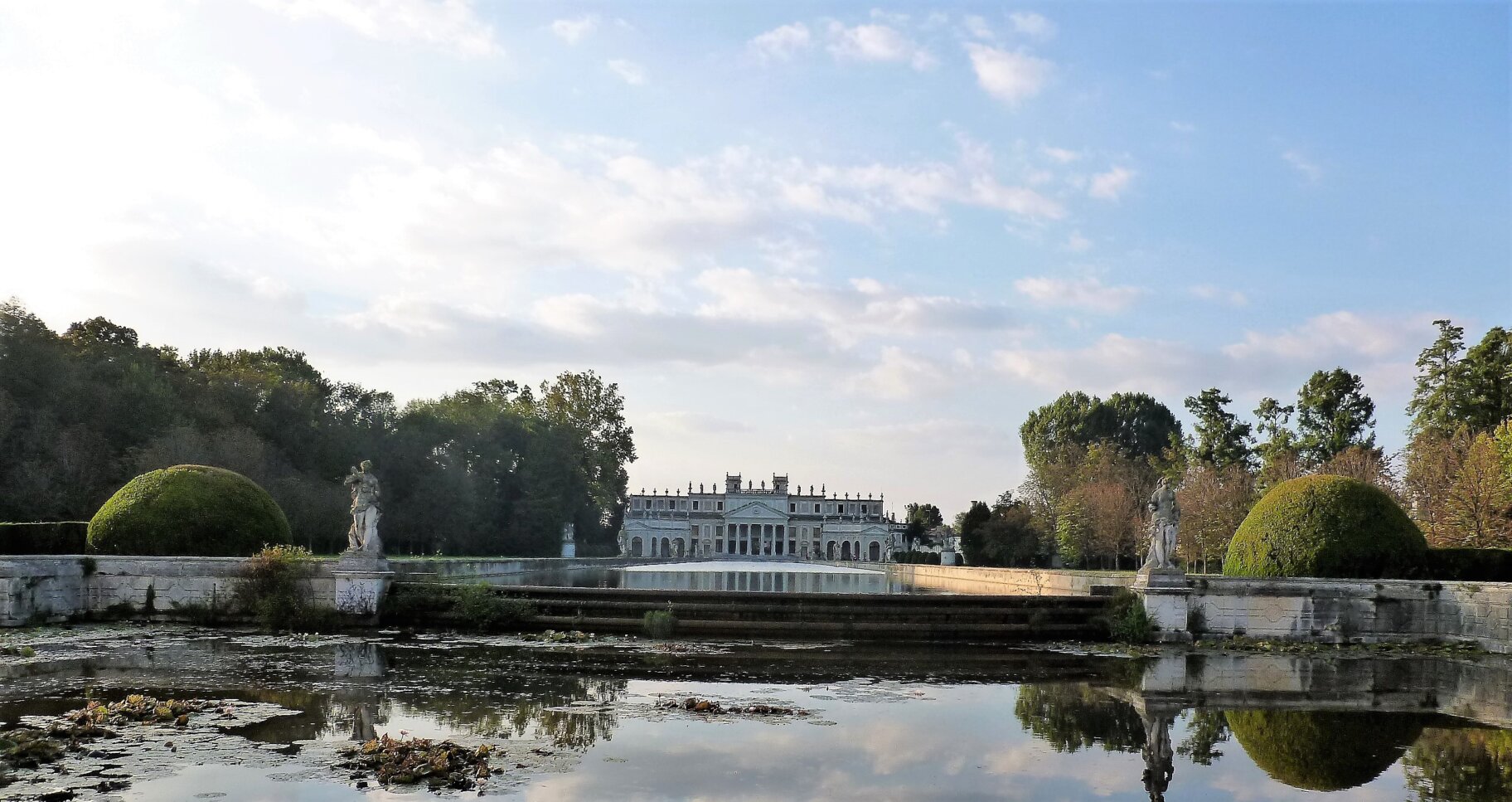
The image has to be conceived as a unity, as a “totality and allness.” It “shows the world not as a mirror, but as a meaningful context […] realized in the structure of visibility. Insofar, the image is capable to represent the totality of the visible world [in question] and its meaning.” 12
In this way, imagining space and experiencing space belong together. It is about what Erwin Panofsky called Bildgehalt, the very essence of an image, its self-revelation. The more idea (inner image) and form (visible image) come closer to each other, he says, the more such a ‘Gehalt’ becomes apparent. Gehalt is what a work reveals without explicit emphasizing, it is an involuntary disclosure of a societies’ or culture’s basic attitudes, condensed into a single work, e.g., of architecture.13 This Gehalt is equivalent to a work’s basic meaning.
Gehalt is associated with style. A culture is expressing itself through its unity of style, Nietzsche said; next to others in the moulding of its spaces, and in its architectures. The most encompassing, general definition of style is the specific manner to do something. It is the force that unites the diverse and dispersed,14 e.g. different buildings made in the same style, the style of living, of clothing, etc. Important for ideal spaces is the connection between ideas and style: Style is equivalent to the form in which a Weltanschauung, a certain world view or ideology is presenting itself. In case of architecture, for Viollet-le-Duc, a stylish 19th century-restorer of historic buildings, “style is the becoming visible of an ideal, based on a principle.” That principle defines the canon of forms with which the ideal in question gets expressed.15 For instance, the principle of Renaissance arcade- and column orders, or the modernist principle to avoid ornamentation.
For ideal spaces, the connection between style and ideas is crucial. Ideas express themselves in a certain style, e.g. the architectural lead ideas of a Renaissance, Baroque, or modernist era articulating themselves in certain architectural typologies. And vice versa, a style gives hints for the ideas which led to it, and for the mindset these ideas are embedded in, and part of: why a modernist era for instance abandoned ornaments? Why its architectures focused on glassy facades, simple forms, large dimensions?
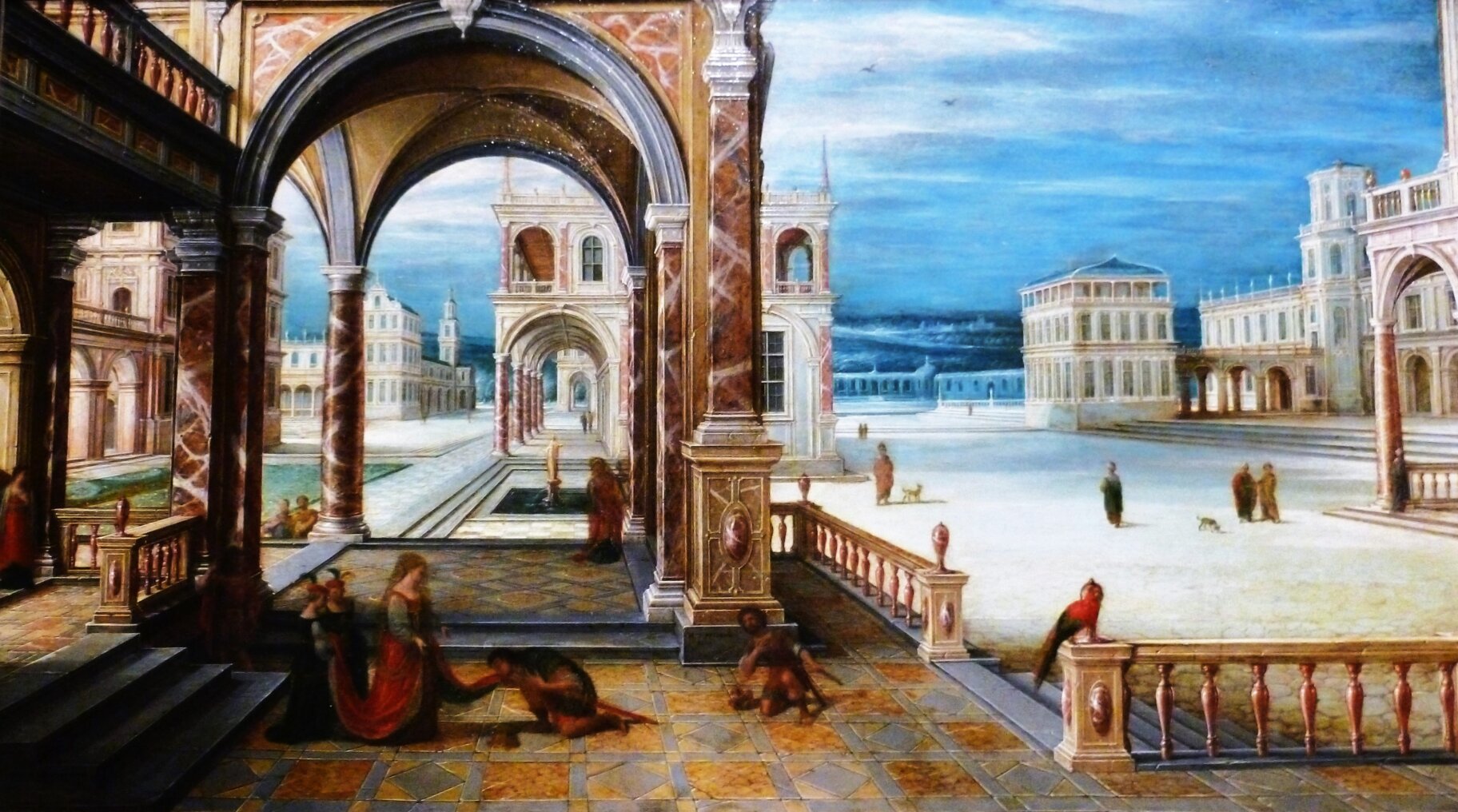
As a carrier of meaning, architecture always is equivalent to the expression of a certainsymbolism. Even in those cases where the notion of the symbolic has been abandoned as an explicit architectural goal in favour of pure functionality, according to the modernist credo of form follows function. Here, too, architecture is a carrier of meaning, standing for a certain mindset: what is important, what not, upon what to focus, what to abandon. In that sense, the architectures of infrastructural networks, “junk landscape”-city outskirts with their mixture of gasoline stations, shopping centres and highways are as well standing for a certain mindset asfor instance a cathedral does, or a baroque ensemble.

Moreover, because symbols are not just codes or signs, they can be understood as “illustrated metaphors of cultural change.”18 A change in symbolism is an indicator of underlying changes in world view (what is relevant, what not) and mindsets. Different architectures are the expression of such changes having taken place, e.g. the transition from Gothic to Renaissance, or from a premodern to a modern architecture.
At the same time, some lead ideas and their symbolic remain part of a cultural memory, irrespective of their changes in expression through history. Mostly, such ideas have a mythic substrate; for instance the myth of paradise, prevalent in our ‘Western’ or ‘occidental’ cultural sphere.19 It is a myth that directly relates to ideal spaces in the sense of “perfected” and utopian spaces because for quite many of them, it was their leading image, the mythical eidos theybasically followed, explicitly stated or not. As a utopian propensity, “Paradise in its Judaeo-Christian forms has to be accepted as the deepest archeological layer of Western utopia, active in the unconscious of large segments of the population […] testimony to the enduring power of religious belief to keep alive the strange longing for a state of man that once has been and will be again.”20
Ideal spaces and myths
The unconscious has been addressed in the above citation, giving a hint of how such lead ideas work, together with their mythic substrate: as a kind of unthought known, as knowledge base that is used but the contents of which are not completed in a conscious manner: 21 We know that we know without explicitly knowing it.
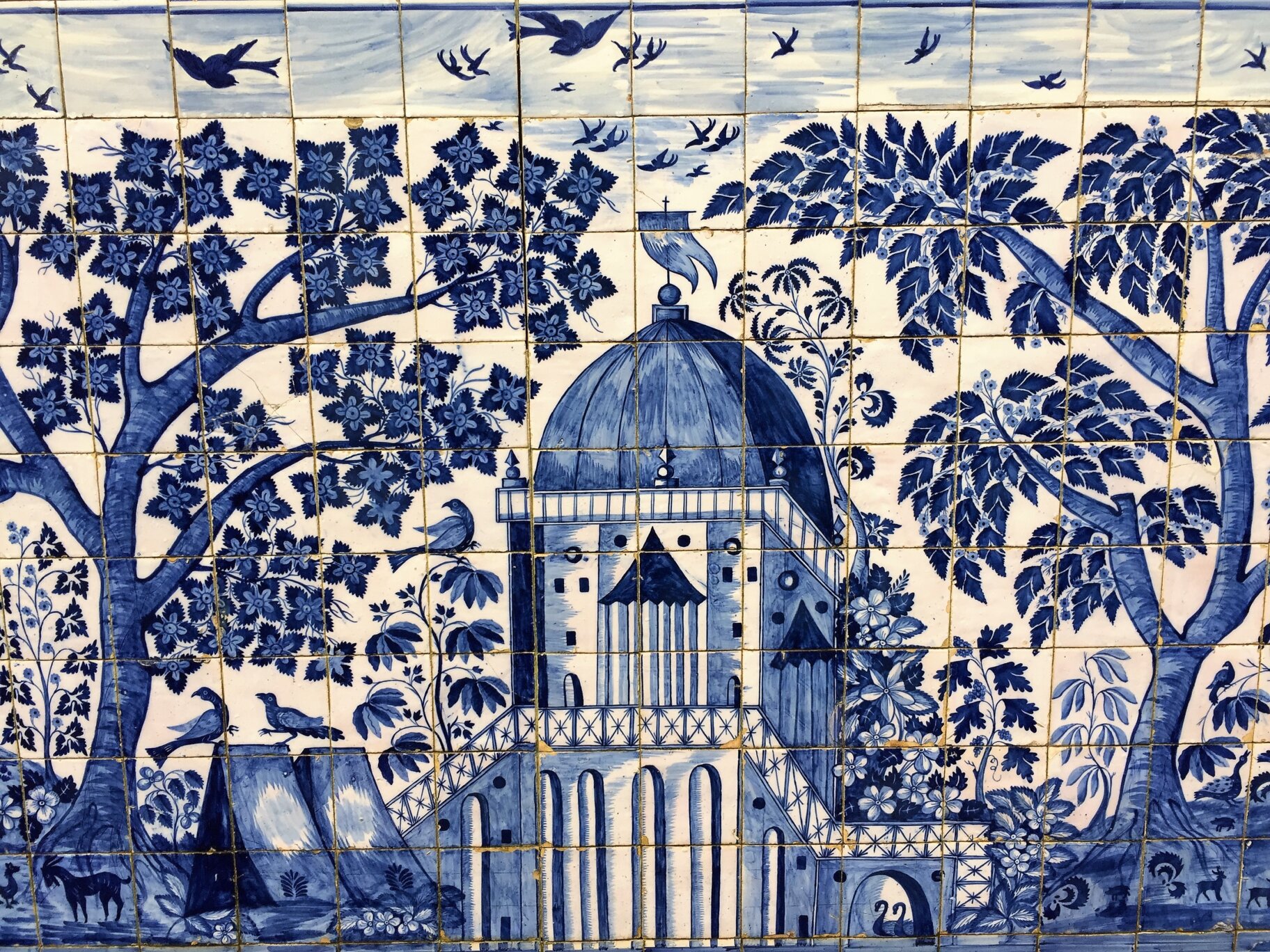
Myths are the spiritual essence of ideal spaces and belong to their prime driving forces. Above, we see a secularized version of the original paradise, the Garden of Eden, together with its central two trees, the tree of life and the tree of knowledge, in the midst of an Arcadian scenery. To refer to the topic of symbolism addressed earlier, this is an ideal space expressed with relatively little means (no extensive linear perspective or naturalistic style, no fully elaborated details) but nevertheless, we know what it is. And we also know that the original Eden did not look like that, nor that future Edens made by humans will do. But despite all this, we know what it is. The image is a full representative of a real Eden, no matter how that real one might have looked like, or may look like in the future. Myths, the Roman writer Sallust said, are pictorial tales that never happened in this way; but they are nevertheless true because they are happening all the time.23
Even more so if myths appear in their disguised, secularized modern variants; for instance, the myth of Paradise which is constitutive for ideal spaces. Myths have a floating relation to history, states a modern author, due to their existence as a universal phenomenon in human history. They combine “a time-bound and cultural-specific expression with timelessness” because of their anthropological necessity: myths provide meaning and hence, orientation and identity, no matter their concrete expressions adopted in time, and culture. “In the mythos, the essential and existential of being human comes to expression, the design of archaic images of the human existence, having a timeless substance. We encounter an existential knowledge that defies fixation by [rational] terms and causalities.”24
It also concerns the “mythification” of the today’s technical universe. Since irrespective of its denial the eschatological element is still prevalent, which shall be achieved now by its instrumentalization. The concomitant quasi-mythification was easy to achieve because “[…] the scientific-instrumental access to the world owns parallels to the mythic one. It also causes a comprehensive, even if not holistic transformation and imprinting. That in turn is no coincidence because also this transformation, via byways, is rooted in the mythical space of the Judaeo-Christian cultural sphere. The base of the occidental modern scientific domain finally consists in a vision of development that directs towards a paradisiacal final state.”
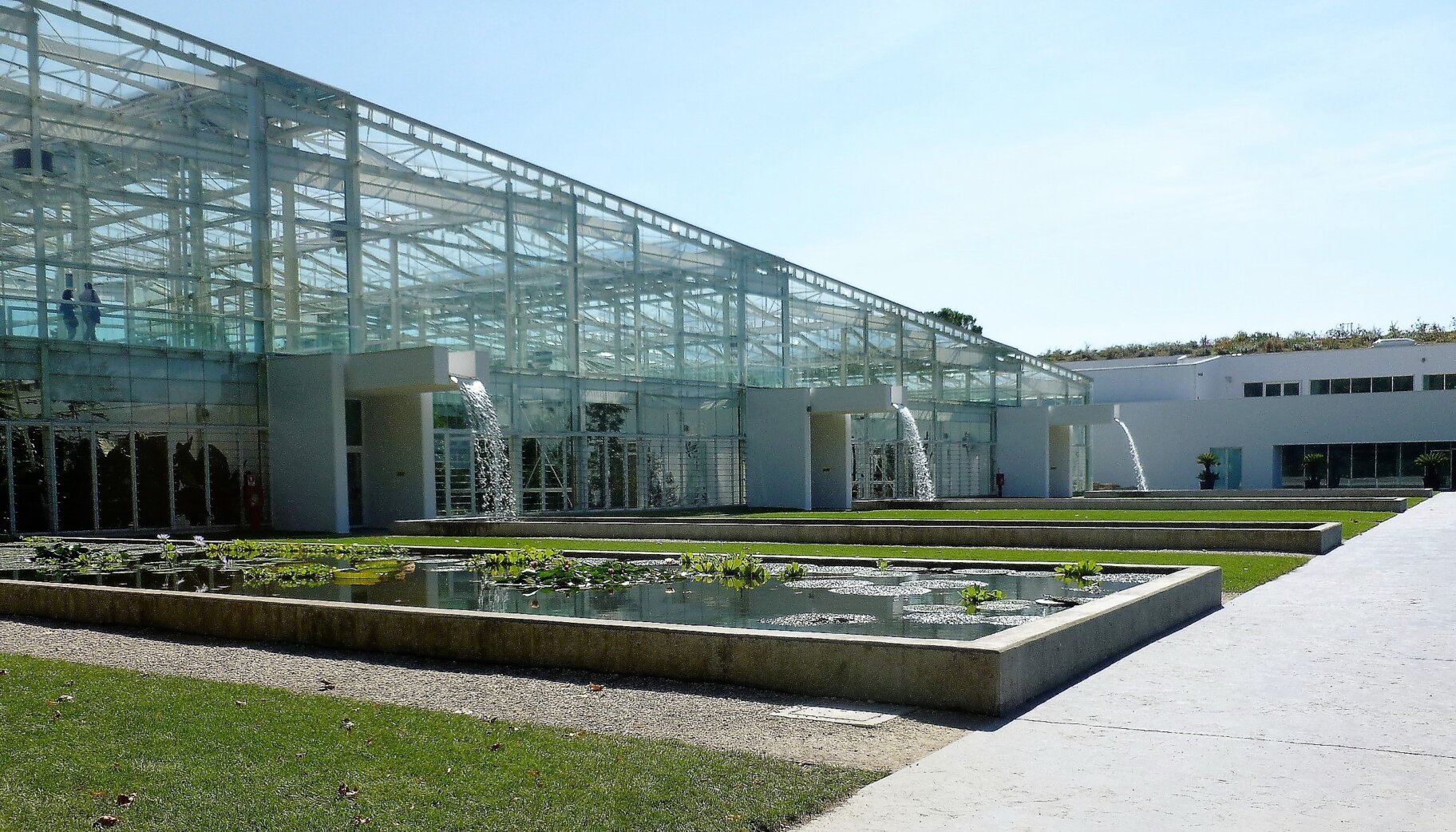
Ideal spaces, utopia, architecture, and community
Myths relate to a conditio humana, a general human condition and ergo, to history; since one crucial element of such a condition is to have history. The mythic longing for a paradise to be regained gives history a direction and thus, a meaning. History becomes more than just a contingent accumulation of events bare of any meaning; on the contrary, history turns into a promise – of redemption. That one day, it will be possible to lead a life more human than that life was in the past, liberated from evil, pain, suppression and other shortcomings. In other words, it is about utopia, about an eu-topian state of existence that can be reached.
Or at least, that we come in the near of such an end-state, brought about by a continuous flow of technological optimization, to reach a state where there is less of negative factors than it is now: that things get easier (the core of every technological promise), less time-consuming, less painful, less bound by material constraints and the (still) unavoidable fact that humans remain material beings.
The myth of paradise – that paradise in its original state might be lost but at the same time, can be really reached again – is not the only myth that influences conceptions of ideal spaces, but inside our cultural sphere, a so-called West or Occident, probably the most influential one. Since it contains a promise: that it must be possible to construct a space perfectly suited to human needs, assisting in the liberation of those traits of a conditio humana which are conceived as positive. Whatever ‘positive’ means, depending on the time and the specific socio-cultural context where the respective ideal space was conceptualized.
In any case, history gets a direction. In the myth’s original Judaeo-Christian version, it tells that history started from a primordial paradise – now irreversibly lost – proceeds through different stages of civilization and will end in a second, and final paradise. Which is an artifact as it was the first paradise already, the Garden of Eden, because both paradises were made by God. The second paradise is the Heavenly Jerusalem, the City of God; and its secularized variants, the different ideal spaces of an eu-topian end state. In other words, history proceeds from one world as ideal artifact – Eden – to a second, final world as ideal artifact – the City of God and its secularized utopian pendants.
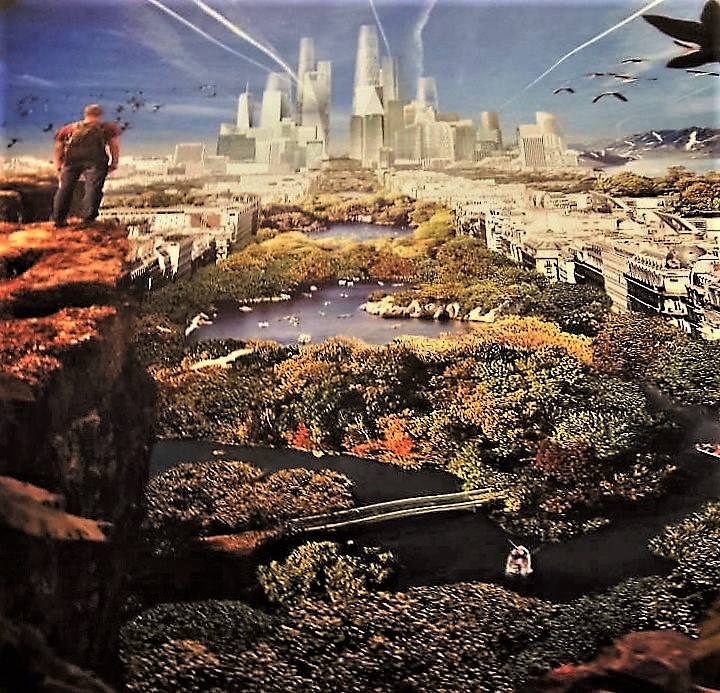
Between the poles of these two ideal artifacts human history is spreading out; and the respective utopian ideal space at pole 2 marks the end of history. Since every ideal space in the sense of a perfected space is an end state, by intention. Otherwise, it wouldn’t be perfect.
In its eu-topian intention, an ideal space does not only relate to utopia, but also to community. And of course, to ideas about a generalized human condition, a conditio humana, mostly in the form of an unthought known. For this generalized condition, architecture shall provide the proper surroundings, the basic frame for such a condition in its realized, actual terms.
Architecture can be understood in very broad terms as the making of spaces, no matter if just single buildings or entire ensembles are concerned, and no matter if we speak about visible, physically built space or the ‘invisible’ architectures of institutional organization, e.g. the socio-political architecture of an ideal state, or the organizational architectures of a statal organ, the United Nations, or an international holding. These cases also embody architecture= a certain deliberate structuring of elements and the relations between them; despite their architecture is not directly visible, opposed to the structuring of built physical space. Such ‘invisible’ architectures can be made visible by auxiliary means, e.g. by drawings of organigrams, of networks, and so on, but as such, as architecture, they not directly visible.
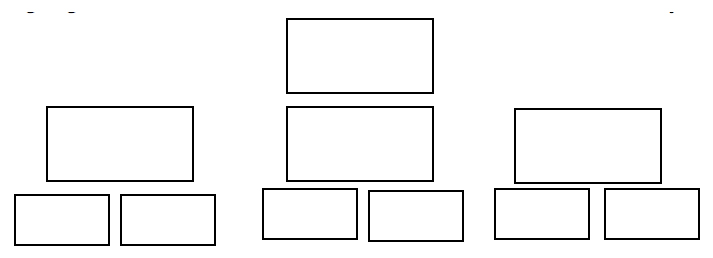
But both kinds of architecture, the visible as well as the invisible one, are making up a space. In case of visible architectures constructing physical space, it is self-evident. In case of organizational invisible architectures, it is the organization space of how people shall act and behave; it is also a topic addressed in our second podcast, the one on Managed Spaces, at https://www.idealspaces.org/podcasts/managed-spaces/
That kind of space influences behaviour, too, as all of us know who worked inside the terms of such organizations. And it is that kind of space which is of prime importance for utopian constructions: to provide an organizational frame of, and for social engineering, that is, to direct human behaviour in certain directions desired by the planners of such a frame. In this sense, the architecture of prime importance for a utopia is not the physical, built space but this organization space. The search for the ideal space becomes the search for the ideal organization. This is the true architecture of a utopia, the structure of the organizational world it provides. In these terms, it is about the right world making for the right human beings.
What applies to every architecture, namely to be based on ideas about a conditio humana, does hold true in particular for the architectures of spaces planned and conceived to embody ideal ones. For which kind(s) of humans such spaces are designed? What shall be achieved with them, as regards such a condition? The underlying assumption is that architecture influences human behaviour, in a good or bad sense. For ideal spaces, the assumption is that these spaces will be able to meliorate human behaviour, towards its better ends. In its essence, this is the underlying (assumed) basal connection between ideal spaces, a conditio humana, and utopia. In the first instance, humans behave; then, they also make other things.
Finally, at least in their eu-topian variants, such spaces shall serve the needs of a community. Since living in communities, to behave as a social animal or zoon politikon, is the most basic trait of being human, of a conditio humana; no matter how such a condition might otherwise look. The problem with ideal spaces designed for communities – as physical as well as organizational architecture – is that they are not historically grown, own no history in that sense. Based on the assumption that a true community needs place, and not just space, it is about the anthropological place, as Marc Augé termed it. Such a place has three characteristics: it is a place of identity, of belonging, and of history.27 It needs history, the growing of such a place in time, that it can develop qualities of identity and belonging at all.

But an ideal space is not historically grown, it is made anew; so, the question remains how identity and human belonging can be attributed to it, how this shall be achieved. Furthermore, the intention of most utopias was to create a new ideal space, a one that has no connection to the historically grown because that had to be abandoned. In particular modernist architecture avoided any connection to history. Fundamental to a modern world, says Henri Lefebvre, is the brute liquidation of history and of the past.29 Aligned to it was the hope for new, even ideal spaces which were better suited for being truly human than anything before. With a little goodwill, so Piet Mondrian, one of the pioneers of modern art and architecture, it will be possible to create earthly paradises.
The utopian hope of a myth of paradise shines up again, together with its nightmare: to cite Augé, the actual non-places of modernity. Which are a utopia too, if we take the term literally: an ou-topos (from which the word ‘utopia’ derives) is a non-place. It can be a place we are longing for, a better place, achieved for instance through the construction of an ideal space; or it can denote a non-place for being human, a place where human beings deserving the name cannot, and should not exist. As for instance the recent urban agglomerations are, or the monotonous bulk of modernist architecture whose historical remnants still constitute large parts of our recent urban environments. And which elicit the need for new, ‘ideal’ spaces to be constructed, to overcome such a misery.
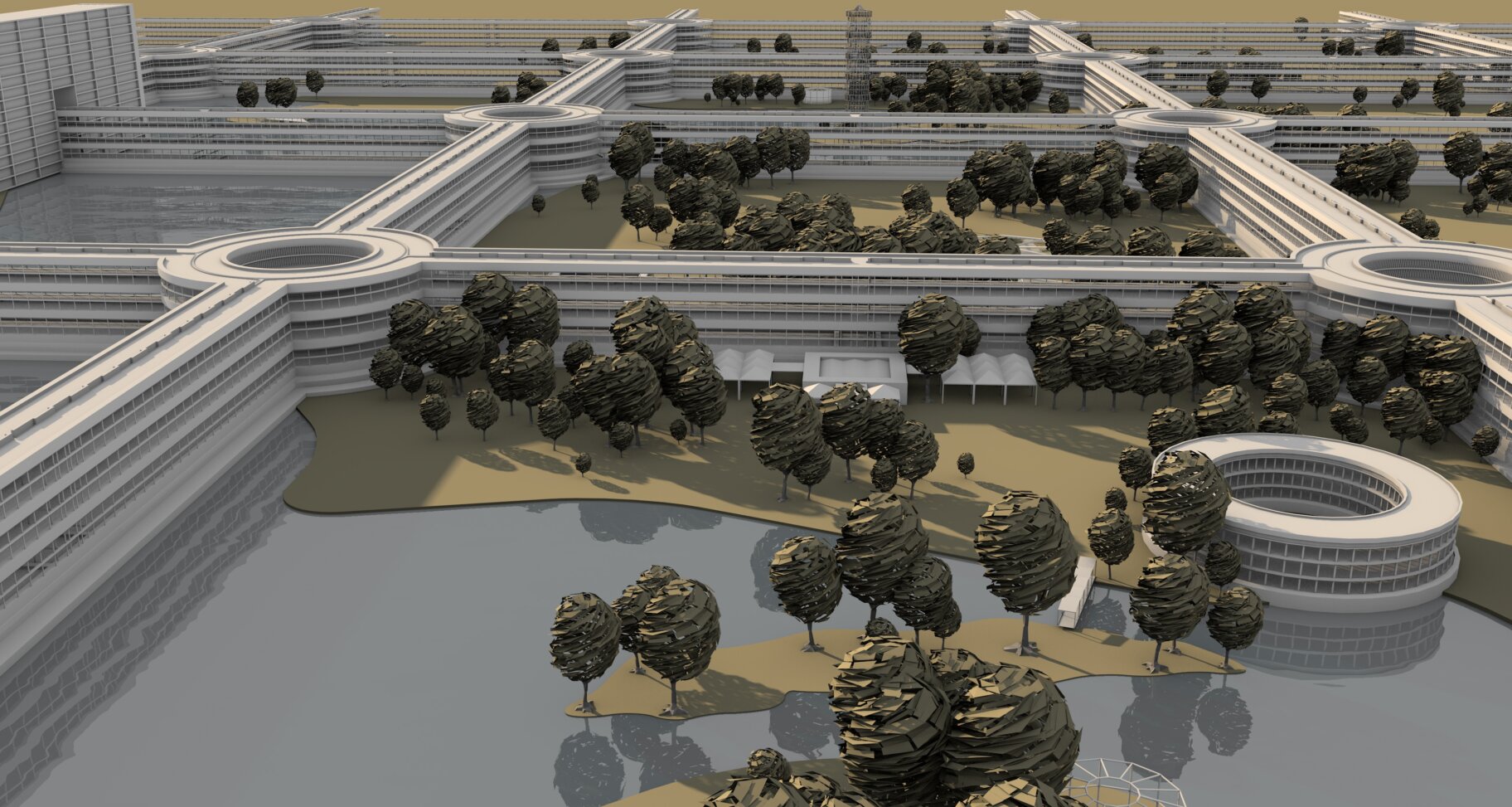
The basic question remains: how an ‘ideal’ space can become a real anthropological place? A place where communities can develop again, and not just agglomerations of people? To achieve this, what has to be re-considered? Which new concepts can be used, including history as well as a new understanding of what a ‘community’ means?
Amongst others, these are questions our working group is concerned with. And due to their practical relevance, they need to be addressed: the majority of the world’s total population lives in urban agglomerations today; and in the near future, the majority of them will live in slums, or slum-like conditions – in terms of a utopia’s second meaning, the majority of the human population will exist in non-places. Is this human?
1 Gemoll, Wilhelm (ed. 1965): Greek-German Dictionary: 383
2 Cloister Ottobeuren/Germany, tile from a wall decoration (photo by U. Gehmann)
3 in Portoghesi, Paolo (2000): Nature and Architecture: 118
4 Cassirer Ernst (1954): Philosophie der symbolischen Formen I: 41. And Foucault from Psarra, Sophia (2009): Architecture and Narrative. The formation of space and cultural meaning: 217
5 Greensboro, North Carolina/USA, end of 19th century. Source: wikimedia
6 Coiningly, a Sinnbild translates into English as symbol. To the full representative: Susanne Langer cit. in Böhme, Gernot (2001): Aisthetik. Vorlesungen über Ästhetik als allgemeine Wahrnehmungslehre: 152
7 Goethe cit. In Hoffmeister, Johannes (1955): Wörterbuch der philosophischen Begriffe: 584
8 Gemoll (op. cit.): 20. And Böhme (op. cit.): 7, 40f., 73. To evidence as unity of expression and meaning see Plessner, Helmuth (2003): Conditio humana. Gesammelte Schriften VIII: 158
9 Knobloch, Eberhard: Eberhard: Das Naturverständnis der Antike. In: Rapp, Friedrich, ed. (1981): Naturverständnis und Naturbeherrschung, 10-35: 24; and 12ff., to its early origins. And Gemoll (op. cit.): 242
10 Travers, Andrew: Seeing Through: Symbolic Life and Organization Research in a Postmodern Frame. In: Turner, Barry A., ed. (1990): Organizational Symbolism, 271-286: 273
11 Park Villa Pisani, Brenta/Italy, view of the central axis (U. Gehmann)
12 Nohl, Hermann (1920): Stil und Weltanschauung:42, and 22, to the relation image – world.
13 Panofsky, Erwin (1978): Sinn und Deutung in der bildenden Kunst: 18, 38
14 Mitchell, W.J.T. (2008): Bildtheorie: 183. And Burckhardt, Martin (1994): Metamorphosen von Raum und Zeit. Eine Geschichte der Wahrnehmung: 30, to style as force
15 To style and Weltanschauung see Nohl (op. cit.): 22. To Viollet-le-Duc see Kemp, Wolfgang (2009): Architektur analysieren. Eine Einführung in acht Kapiteln: 11
16 Hendrick van Steenwyck the Younger, 1610: Courtyard of a Renaissance Palazzo, section. London, National Gallery. Photo U. Gehmann
17 Carrefour Senart, France: entrance to a shopping centre. Photo U. Gehmann
18 Crossley, Paul: Medieval architecture and meaning: the limits of iconography. In: The Burlington Magazine, Feb. 1988, 116-121: 116
19 The myth of Paradise also existed in other cultures, but not so predominantly shaping than it was the case in our one, influenced by a Judaeo-Christian heritage. Cf. Krauss, Heinrich (2004): Das Paradies. Eine kleine Kulturgeschichte: 9f.
20 Manuel, Frank E./Manuel, Fritzie P. (1997): Utopian Thought in the Western World: 33
21 Bollas, Christopher (1987): The Shadow of the Object – Psychoanalysis of the Unthought Known: 287f.
22 Jardim Tropical, Funchal/Madeira: azulejo at a fountain wall, 17th century. Photo U. Gehmann
23 In Stumpfe, Ortrud (1978): Die Heroen Griechenlands – Einführung des Denkens von Theseus bis Odysseus: 3
24 Eurich, Klaus: Mythos und Maschine. In: Flessner, Bernd, ed. (2000): Nach dem Menschen. Der Mythos einer zweiten Schöpfung und das Entstehen einer posthumanen Kultur, 19-41: 19. And 24f., in the following.
25 Orto Botanico, Padua/Italy: new glass house. Photo U. Gehmann
26 Exhibition poster, Trocadero Museum Paris. Photo U. Gehmann
27 Augé, Marc (1995): Non-Places. Introduction to an Anthropology of Supermodernity: 52
28 Central square („campo“) in Siena/Italy. Photo U. Gehmann
29 Lefebvre, Henri (ed. Of 2007): The Production of Space: 122. And Mondrian cited in Warncke, Carsten-Peter: Die neue Stadt für die neue Gesellschaft. In: Nerdinger, Wilfried et al, eds. (2012): L’Architecture Engageé. Manifeste zur Veränderung der Gesellschaft, 170-183: 174
30 Screenshot from Motopia, exhibition Ideal Spaces, Venice 2016 (Andreas Siess), here on this website.
Listen also to our podcast.
